
Clay is found abundantly in nature: its remarkable qualities of plasticity when wet and hardness when dry; its imperviousness to heat; its readiness to be worked without the need of any tool but the hand, make it an ideal raw material. One would therefore assume that clay played an important role early in the story of man; but this is not so. Cultural man who appeared on earth at least 2.5 million years ago, turned his interest first to hard and sharp materials such as flint, bone and wood: cutting and piercing tools are the first needed by a primitive culture.
To estimate when clay was adopted is not easy: body paint and as medicine, two of its most common uses among primitive people, do not leave any trace; unfired clay used for shelters of wattle and daub or modelled into some artifact is subject to weathering and rapidly disintegrates. This may be why none of the paleolithic sites excavated on either the Iraqi or Iranian side of the Zagros (Shanidar, Barda-Balka, Bisitun, Ghar-i-Khar, Hazar Merd, Palegawra, Warwasi, Zarzi and Hotu) yield any evidence of the use of clay. However, an even more likely explanation for this conspicuous absence is that clay, because of its heaviness and fragility, is of little or no use to unsettled hunters and gatherers. It is noticeable that the rare European paleolithic sites which yield clay, such as Dolni Vestonice and several French caves, were all sites which had acquired a definite permanence of occupation. It would then appear that, as long as man lived as a nomadic hunter, the spectrum of the raw material he used was very limited: in the beginning of the ninth millennium B.C. at Zawi Chemi (where a single unshaped lump of clay was recovered), it must have been restricted to stone, bone, antler, skin, shell and vegetable matter.
At last in the middle of the ninth millennium B.C., coinciding with first evidences of early sedentarization, clay begins its career in the Zagros, and altogether Karim Shahir, Tepe Asiab and Ganj Dareh produced quite a number of clay objects. Thereafter, paralleling the progress of sedentarization, the evidences of the use of clay steadily multiply, so much so that the vast quantity utilized in the settlements throughout the centuries accumulates to shape the artificial hills known as mounds, tells or tepes. My purpose is to review the evolution of the beginnings of the use of clay in the Zagros. This I have divided into three stages:
I. 8500-7500 B.C., the use of clay limited to small objects.
H. 7500-6300 B.C., clay used as a building and refractory material and for the storage of goods.
III. 6300-5800 B.C., general proliferation of pottery containers.
Stage I

The time encompassed by Stage I roughly spans the thousand years between the middle of the ninth and eighth millennia B.C. The sites: Karim Shahir, Tepe Asiab and Ganj Dareh Tepe (level E) are still probably temporary encampments showing, however, new trends toward an economy based on more intensive food collection or an incipient cultivation of cereals. Also, the domestication of sheep may well be achieved. It is in this setting that clay makes its appearance. At Asiab a sizeable quantity of small, hard clay rubble suggests that the oval “pit-house” may have been covered with a roofing of wattle and daub. Otherwise, the use of clay at this stage is limited to figurines and small geometric objects such as cones, spheres, discs and cylinders.
Human figurines are rare: two at Karim Shahir and, counting all fragments, at most half a dozen at Asiab; they are of minute size (2 to 4 cm.), sexless and extremely schematized. No stereotyping is yet noticeable, and each figure is unique: one example from Karim Shahir stands on two little feet pointing out of the mass, its faceless head projecting backwards; from Asiab a featureless figure has outstretched arms, a second has legs and arms looking like stumps, and a third is a plaque-like face with a pinched nose and a scatter of circular reed incisions. The prototype of the fat Venus is not yet created. The meaning of these figurines is a mystery; they have been in turn interpreted as toys or deities (sic transit gloria Dei: God who once created man out of clay is in his—or her—turn made of clay by man!).
The number of animal figurines is equally small: at best, perhaps four can be identified as such at Asiab. Only one is intact; it represents the head of an unidentifiable little animal, fashioned without a body, with a pinched nose and ears. At Ganj Dareh, half a dozen sheep and goats modelled in the most unsophisticated way with short, rounded legs represent the prototype of the animal figurines of the next millennia.
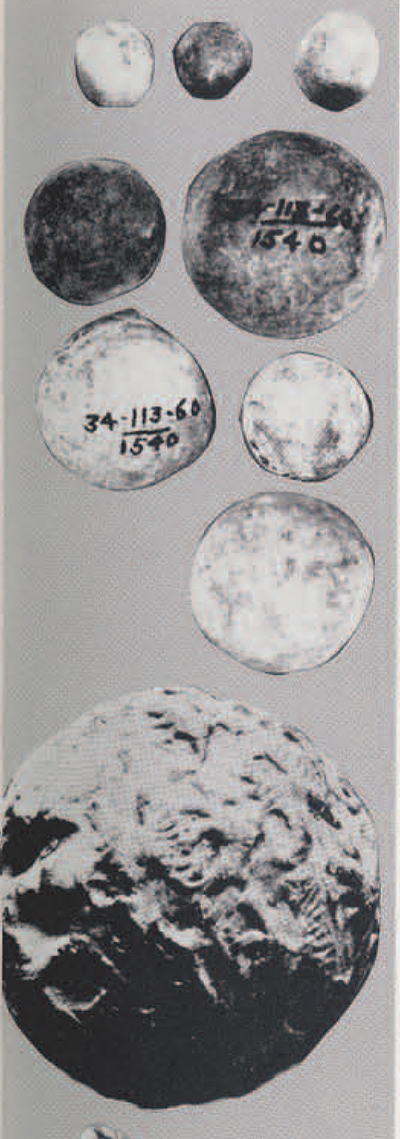
Geometric objects were found by the dozen at Asiab and Ganj Dareh. They are shaped according to well defined and standardized forms, mostly cones, tetrahedrons, spheres, discs and cylinders. The cones and tetrahedrons range from 0,5 to 2 cm, in base diameter; the spheres are represented in two sizes, small pellets 0.5 cm. in diameter and balls 2.5 to 3 cm. in diameter; the discs are either flattened pellets 1 cm. in diameter (present at Asiab only) or flat or plano-convex discs 2 to 5 cm. in diameter and 1 cm. thick, sometimes thinly perforated in the center; the cylinders are thin coils rolled between the palms of the hand (present at Asiab only), 1 cm. or 4 cm. long and 2 mm. thick. Asiab adds to this repertory a long list of less popular forms represented by a single or a few specimens, among them a crescent, a square, a triangle and also composite and complicated shapes. All these objects have puzzled many archaeologists, and the fact that they seem to be omnipresent in space and time makes them even more intriguing. The top chart on page 15 summarizes their distribution from Turkey to the Caspian and from the ninth to the third millennium B.C., when at last they appear in a meaningful context, which may provide the key to their understanding.
At Susa in 3300 B.C., the cones, tetrahedrons, spheres, discs, cylinders are found tightly enclosed and duly sealed in spherical bullae. The bullae are archives of transactions; each geometrical object within is a calculus standing for a specific item, while its size and number express the quantity of the exchange. Later in the fourth millennium when writing was invented, the cones and spheres were translated into two-dimensional pictographs and were drawn with a stylus on clay tablets. Even later, in the sophisticated Mesopotamian arithmetic system of 2500 B.C., the sign standing for the numeral 1 is still a small cone, while a small sphere is 10, a larger cone is 60, a large cone with an engraved circle is 600, a large sphere is 3600, a large sphere with an engraved circle is 36,000, and so forth. It may well be presumptuous to assume that the geometric objects were used as calculi from the ninth to the third millennium B.C.; however, the representation of a fundamental concept such as the number one (or one of a kind) would probably involve permanency and universality and would provide an explanation for their wide distribution and the consistency of their appearance. For what purpose would these early calculi have been used? To count the animals of the flock? To keep record of stored goods? For barter? For games and gambling? To keep track of time?
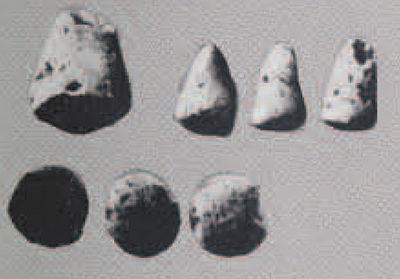
The clay selected for the manufacture of these small objects was fine-grained montmorillonite. It seems that it was used without any preparation and the few inclusions in the composition, such as sand and possibly bits of grass, were accidental. The hardness of the objects and their color varying from buff to reddish but with a great quantity of grey to black specimens made me suspect that they had been fired in an open campfire of wood which would produce zones of various atmospheres; oxidizing at the periphery and reducing in the middle. A series of tests have been performed to try to verify this observation. This was made possible thanks to R. J. Braid-wood and B. Howe who generously provided four samples from Asiab and four from Sarab (c. 6000 B.C., Stage III) and thanks to W. D. Kingery, Head of the Division of Ceramics at M.I.T., who kindly gave of his interest and time to direct a series of tests on the samples.
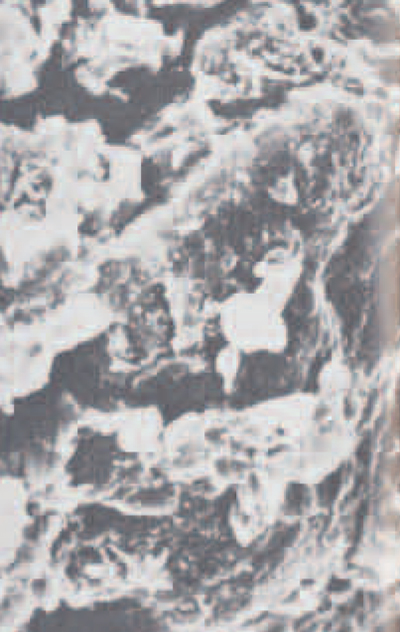
Differential thermal analysis was first tried. This is based on the fact that exothermic and endothermic effects are produced by physical and chemical transformation of material (dehydration, oxidation, fusion, vaporization, crystal transitions, etc.). Powdered samples from each site were placed individually in a source of heat at constant rate (10°/m.) and their reactions were measured in comparison to an adjacent sample of inert material (aluminum oxide). The graphs exhibited a substantial endothermic peak at a temperature of about 200°C. corresponding to elimination of water (thus behaving like unfired material—however, previous tests performed by W. D. Kingery on Sialk sherds had shown the same reaction, demonstrating that, after a period of several millennia in the ground, the material, though fired, had been capable of rehydration—thus making inconclusive the interpretation of this reaction). The graph showed a second peak in the region between 800 and 900°C„ which is characteristic of the crystallization process in montmorillonite; this revealed that crystallization temperature had never been reached previously. In conclusion, differential thermal analysis gave only the negative result that, if firing had been involved, it had not exceeded a temperature of 800°C.
Examination through a scanning electron microscope gave more positive results. Magnification between 20 and 100,000 times could be achieved and the crystal structure which appeared distinctly on the screen could be photographed, Professor Kingery’s analysis of the Asiab photographs concentrated on the fact that the background exhibited an aggregate with noticeable continuity; the ordinarily hexagonal crystals of montmorillonite had lost their sharp edges to become rounded. This modification of the particles would suggest that the artifacts had been subjected to a temperature above 500°C. Results from both tests thus set a range of temperature with a minimum of 500 and a maximum of 800°C.; 500°C. is higher than that usually produced in a domestic oven [no trace of ovens has been thus far discovered in this period); 600-700°C. is the usual temperature of an open campfire.
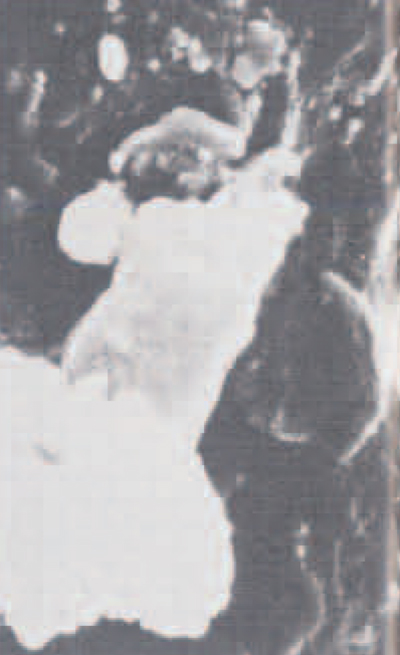
Further tests of refiring are now underway in the hope of determining with more accuracy the temperature at which the artifacts were fired. Because the geometric objects show little evolution in the course of the next stages, they will not be further discussed in this paper. Therefore, it should be noted here that examination of the Sarah samples (from pottery levels) showed that the montmorillonite crystals had preserved their sharp edges, suggesting that, if firing took place, it would not have exceeded 300°C.—a temperature typical of a domestic oven.
Three general points can be made about the use of clay in Stage I:
- Clay is used in small quantities and expresses abstract concepts such as divinities (?) or numbers, thus presaging the choice of clay as the substance to bear the first writing.
- The area of extension of the use of clay is concentrated on two neighboring sites—Tepe Asiab and Ganj Dareh Tepe—which produced almost all of the clay objects. Westwards, Karim Shahir produced only two small figurines; eastwards, Belt Cave (Seal Mesolithic) did not yield any clay remains. The use of clay according to the state of our present knowledge is thus localized in a small area of the province of Kermanshah.
According to the analysis made of Asiab samples, the firing of clay seems to occur simultaneously with the first evidence of its use. (The 23,000 B.C. figurines from Dolni Vestonice in Moravia are also believed to have been fired.) There seems to be no “Ace-ramic Neolithic.”
Stage II
In the second stage (7500-6300 B.C.) successful attempts at complete sedentarization based on herding and agriculture are realized, for instance, at Ganj Dareh, Ali Kosh, Jarmo, and M’lefaat, bringing forth a set of new needs. One of greatest importance, the necessity for long-lasting shelters near the fields and pastures, was successfully met by clay, which proved to be an immediately accessible and inexhaustible raw material. At M’lefaat the pit house involved clay as illustrated by a substantial amount of rubble; at Ali Kosh houses were built of simply packed mud or with slabs of native clay 15x25x10 cm. laid in courses and cemented together by a clay mortar.
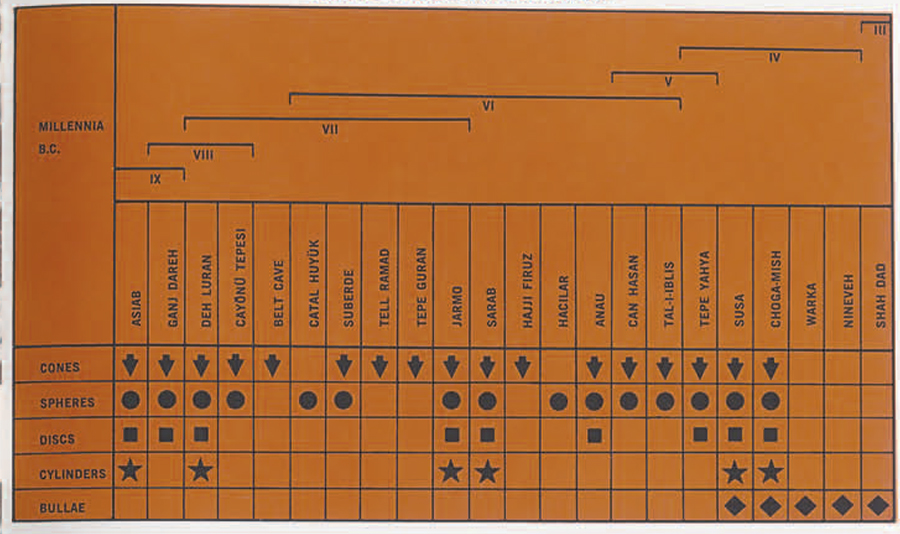
Experimenting on the new raw material soon brought about improvements, leading at Jarmo and Ganj Dareh to a better preparation of the clay—the addition of vegetable temper provided a more uniform penetration of moisture in the mass and increased the plasticity and tensile strength. This mix was moulded in place in successive layers (a technique locally called tauf in Iraq and chineh in Iran). At Ganj Dareh a similar material was shaped into large plano-convex bricks (100x30x7 cm.); once dried in the sun, the bricks were laid in courses, awkwardly placed on the convex side between thick layers of mud mortar. Some of the corner bricks had an ingenious system of bonding consisting of three protuberances at one end and three corresponding depressions in the next brick. Once completed, the walls and floors were generously plastered with clay; at Jarmo a layer of reeds underlay the clay. The rooms were small: 2×2.50 m. at All Kosh and often smaller at Ganj Dareh. (The length of the poles used for the roofs may be responsible for this.) The spaces in the roofing were then also sealed with clay as evidenced by chunks of clay with cylindrical impressions found at Gan! Dareh.
These houses where clay was the raw material for the floor, the substructure, the mortar, the plaster and part of the roofing, fulfilled all the requirements of the early settlers: they were able to resist the elements, were permeable, cool in summer and easily heated in winter; they offered protection against marauding animals.
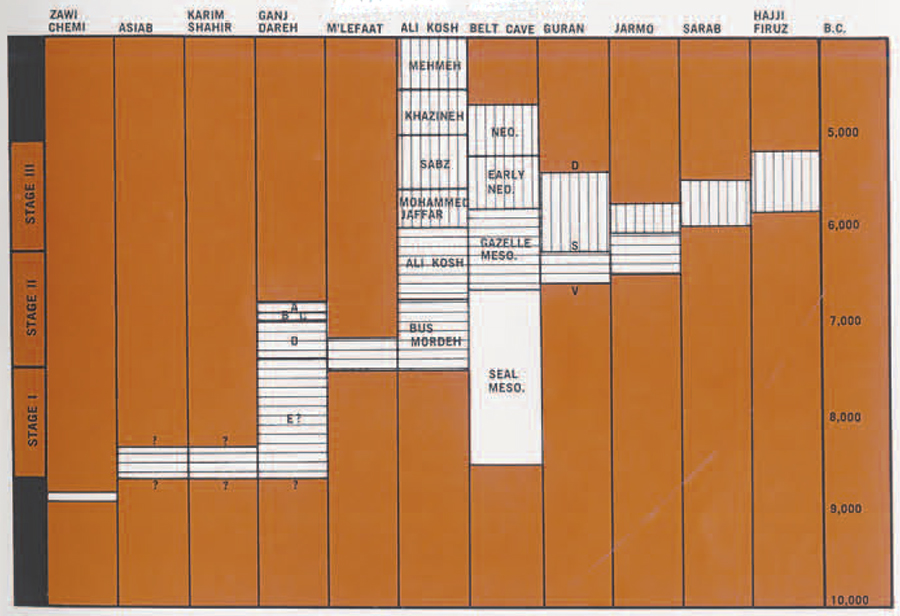
Around the houses clay was commonly used as a refractory material. At All Kash, a depression in the clay floor provided a hearth 50 cm. in diameter and 10 cm. deep. At Jarmo, oval “baked in place pottery basins,” 85 cm. long and 15 cm. deep with sides projecting slightly over the surface ground, were dug in the courtyard and lined with clay; they may have been hearths. More elaborate was a roasting pit situated in a courtyard at Ali Kosh: it consisted of a depression 25 cm. deep and 1 meter in diameter, surrounded by a curb of three courses of mud bricks; the pit was lined with mud showing traces of burning.
Clay ovens represented a further development in the mastery of fire; they confined the heat to a closed chamber, thus preventing any loss by radiation; draft was controlled, thus allowing better oxidation and higher and more uniform temperatures. One of the best preserved examples was found at Jarmo (II, 6). It was a domed, circular structure built of tauf; the fire was fed from the courtyard through a scoop-shaped opening. The chamber was situated 25 cm. higher; its burnished floor had been replastered several times with coarse clay heavily mixed with straw. A semicircular chimney was incorporated in the tauf house wall. At All Kosh and Ganj Dareh, similar structures were built with mud bricks: they ranged in size from 50 cm. to 2 m. in diameter. Cereal grains were found in the open hearth of Ali Kosh, carbonized bones in the roasting pit, but so far no remains have been identified which could indicate a particular use for the ovens at this stage.
A necessity for the achievement of sedantarization was the storage of a portion of the crops for the lean season. Here again clay was the solution. At Ali Kosh storage cubicles 1×1.50 m. were contiguous to the living area. At Ganj Dareh similar cubicles were clustered according to an intricate plan; access to some of them was possible only through a round opening in the side at a man’s height and varying from 30 cm. in diameter to a space hardly large enough for a hand to pass through; the openings were sealed by clay plugs in the shape of flat discs or small bungs, with two deep depressions for grasping. Further adjustments for storage were contrived within the houses: at All Kosh, niches 30 to 50 cm. deep and 30 to 100 cm. wide were left in the brick walls and carefully coated with clay. At Ganj Dareh, bins, large jars and basins were made with a reddish coarse clay and tempered with a fibrous vegetable matter. The dome-shaped bins were tucked in room corners and may have held a capacity of four liters.
The jars were ovoid or carinated. One specimen was found intact: it was 80 cm. high with walls as thick as 5 or 6 cm.; there was no surface treatment; an opening at the base was perhaps original, allowing the vessel to be filled from the top and emptied from the bottom. Some of these vessels were found sealed to the walls. The circular basins had massive bottoms 9 cm. thick and from 80 cm. to a meter in diameter, on which the heavy sides were stuck vertically with no concern for smoothing the joints. These various containers could hold dry goods, such as cereals or nuts, and protect them from rodents, moisture, frost and sun rays. The vessels probably did not require any firing because, once in place, they were not subject to further manipulation.
A number of smaller vessels from Ganj Dareh illustrate how sedentary people were able to increase the quantity of their possessions and even include among them breakable items. Small goblets and saucers were made of a crude ware with pebbles and charcoal inclusions; their color is blackish with an exceptional buff or red sherd. In a finer ware, similar to the paste used for the figurines, a small globular vase was made of two hemispheres later joined together; a number of thin, hard, blackish sherds represent a third type of ware which was decorated with nail incisions in different patterns. These small containers would have little or no practical use if unfired; and in light of the Asiab analysis it would not be surprising if they were fired; however, we have as yet no way to prove that they were. The first two types were found in D and could have been baked in the blaze which ended this level; the third type was found in the ashes of a hearth in level B where again they may have been fired unintentionally. The “baked in place pottery basins” from Jarmo, the storage jars and small vessels from Ganj Dareh all belong to the so-called “Pre-pottery Neolithic,” thus making these chronological divisions based on technology meaningless.
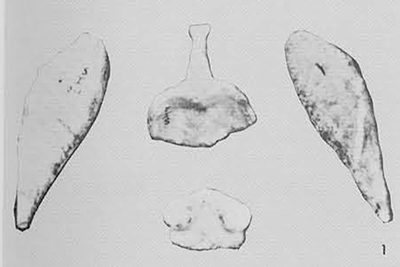
At this stage the human figurines seem to be female. The “Venus” of Ganj Dareh, a curious cone-shaped figure, and several other types from the same site are all provided with opulent breasts. At Jarmo twenty-five examples represent simple seated females with extended legs and occasionally crudely shaped breasts. The squatting posture of the single figurine from All Kosh could suggest giving birth.
Animal figurines were found by the hundreds in the cubicles of Ganj Dareh. Mammals only are represented and mostly domesticated species such as goats and sheep. At Ganj Dareh and All Kosh little stocky animals have a pinched spine, sometimes pointed ears and a short tail; a characteristic type at Jarmo is a pig-like animal with a massive forepart tapering down to a narrower hindpart. Tests performed by Anna 0. Shepard and Vivian L. Broman at Boulder, Colorado, on fragments of Jarmo figurines showed that they were fired or baked to a temperature of 400 or 450°C., thus representing the second tangible proof of firing.
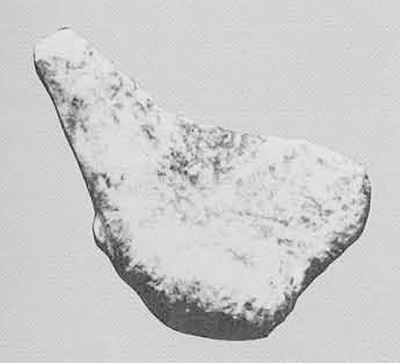
During this stage clay advanced to become one of man’s most common raw materials. Constant experimentation in handling rapidly led to major improvements such as tempering and burnishing. The area of extensive use of clay has extended south to Tape Guran and Ali Kash and west to Jarmo; however, further west, M’lefaat produced only some rubble and two dozen fragmentary, unidentifiable clay artifacts; to the east, Belt Cave, inhabited by a group of hunters and possible incipient herders, yields only five cones and a few chunks of clay, apparently parts of screens of wattle and daub built to divide the cave into compartments or pens. Thus, a peripheral zone with negligible amounts of clay is juxtaposed to the center of intensive use of clay located from Kermanshah to Kirkuk.
Stage III
In the course of the few centuries which represent Stage III (6300-5800 B.C.), clay containers—this time unquestionably fired—spread to all sites of the Zagros: Tepe Guran, Tepe Sarab, Ali Kosh. Belt Cave. Hajji Firuz and Jarmo. At first they appear in modest number but swiftly multiply and become the most common of the remains from the prehistoric household; in Jarmo, for instance. the 1950-51 season reported 204 sherds from levels 5-3 as opposed to 12,000 from levels 2-1.
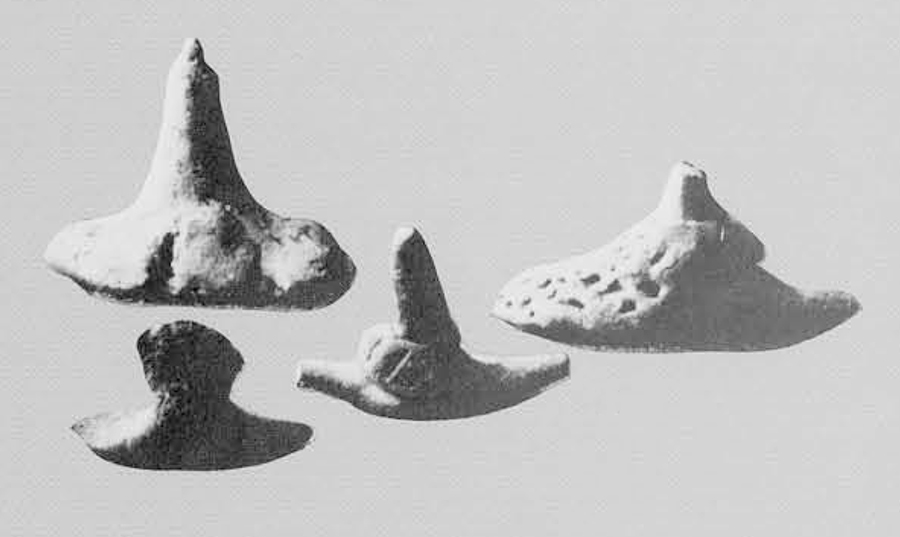
The great majority of the vessels are conspicuously medium-sized bowls ranging from 15 to 30 cm. in diameter and 10 to 15 cm. deep; variations in the shapes include straight or carinated sides; straight, everted or inverted rims; flat or round bottoms. The tremendous success of this particular shape. which was borrowed from stone prototypes, may reveal that, once again, clay was fulfilling a specific new need. The context in which pottery appears may indicate what this could have been. Pottery containers appear at Tepe Guran at the same moment that a settled agricultural community replaces a herder’s encampment, At Belt Cave their appearance coincides with the full achievement of domestication and at the time when goats and sheep are thought to have been milked. The bowls, as well as other less popular shapes, such as mugs, small jars and spouted pitchers, may have played a role in the preparation of some new dairy product, although to us they would not seem appropriate for such use because of their softness and porosity. These defects are the result of insufficient firing; Matson estimated that the pottery from Belt Cave had been baked for a short time at a temperature of at least 700°C.; oxidation did not usually penetrate deep in the paste, and the core was left gray; the color of the vessels, which is brownish in most sites, attests a reducing atmosphere during the final phase of the kiln firing or cooling.
An innovation to be ascribed to this stage is the application of a slip or wash on the outside surface, as attested on the potteries of Tepe Guran and All Kosh; burnishing formerly used in the preparation of oven floors is also commonly applied to the vessels; both methods not only enhanced the appearance of the pots but also diminished their porosity. Furthermore, motifs were painted with red ocher on a number of bowls. The most ancient patterns recorded so far in the Zagros are from Tepe Guran and seem to imitate basket or net work; somewhat later a close pattern of diagonal blobbed lines is usual at Tepe Guran, Jarmo, and Sarah, as well as geometric motifs such as zig-zags, chevrons and open triangles at Tepe Guran, Ali Kosh, Tepe Sarab and Hajji Firuz.
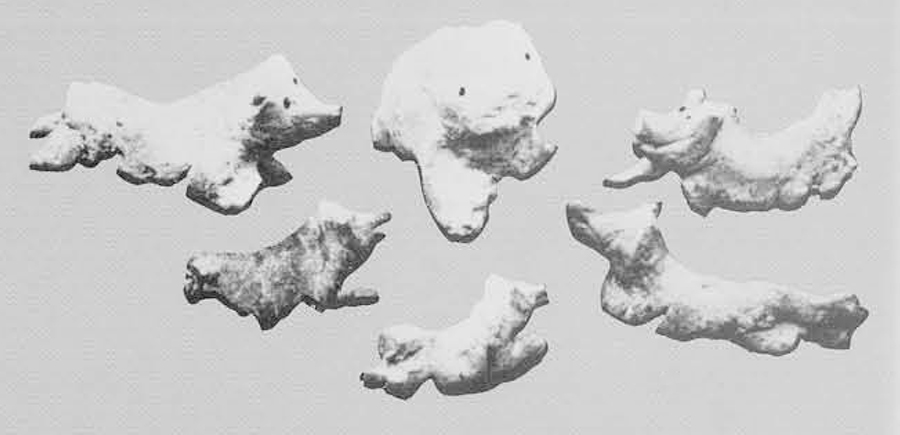
This concern for improving the naturally dull appearance of clay is also found in architecture. At Tepe Guran the inside walls of the houses were colored with a thin layer of white or red-colored gypsum—the first evidence of the use of calcium sulfate in the Zagros; the floors were built in a terrazo technique with small pieces of white feldspar imbedded in red-colored clay, creating a decorative effect. A further improvement within the house is the addition of built-in furniture—a bench and table are moulded in clay and tucked in the recessed wall of a house at Tepe Guran.
Clay at this stage is even employed as a body ornament, and at Jarmo and Tepe Guran buttons, beads and pendants are not rare. They were perforated with a straw while moist and fashioned into multiple shapes: spherical, discoid, biconical, cylindrical, etc. At Ali Kosh bell-shaped pendants seem to have been part of a belt.
New trends now appear in the iconography of the figurines. One type of figure is made of several parts held together with sticks. The famous Venus of Sarah belongs to this group and is made of six different parts: two thick, cigar-shaped legs with groove markings to indicate the musculature; a fat stomach which overlaps the legs; appended breasts; a back which is decorated with a belt of fingernail incisions at the height of the buttocks; and a long neck which ends without a head. Many fragments belonging to such figurines were found at Sarab. The composite figurines from Jarmo are more naturalistic; in some the emphasis may be placed not on femaleness alone but on pregnancy; they are represented seated, the arms are bent at the elbow, and the hands meet over the round stomach or casually rest on the thigh. The head is topped with a coiled headdress and the face is depicted with incised features or pellet eyes.
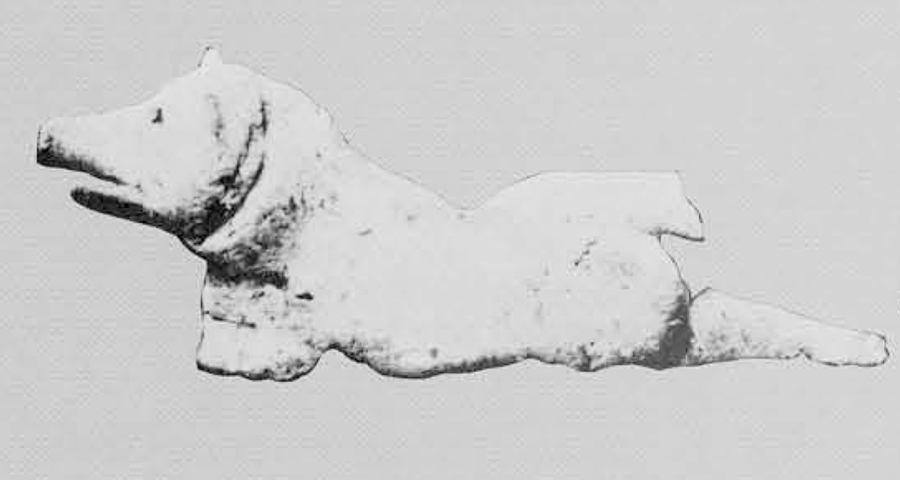
An opposite trend is an extreme stylization: at Sarab female figurines are reduced to a mere pyramid with a slight depression at the base to indicate the thighs; they are also sometimes provided with hanging breasts. The”lady stalks” of Jarmo have a slender, cylindrical body with fused legs and a small head with pinched face. The “T-shaped figurines” of All Kosh consist of a small stalk centered on an elongated base; sometimes they are topped by a patched pellet. The “double-winged base objects” of Jarmo are essentially the same; however, some of them exhibit a roughly pinched face with incised features and an occasional long chin or beard which has led to their interpretation as male figurines. At Tepe Sarah, the stalk is sometimes surrounded by a small lump of clay bearing incised decorations.
A great variety of species, wild or domesticated, are represented among the animal figurines; the 1100 specimens from Jarmo could be divided into at least fifteen different types such as dogs, pigs, sheep, goats, etc. At Sarab the animals are accurately observed and represented in characteristic positions: a dog is relaxing with extended legs, the rugged coat of a bear is suggested by checkered lines.
Stage III is marked by the tremendous success of pottery containers, resulting in its current designation as “Pottery Neolithic” or “Ceramic Neolithic,” as opposed to the preceding “Aceramic Neolithic” (Stages I and II). In the light of this paper, Stage III appears, however, only as a further step in the conquest of clay, a process set in motion in the Zagros in the ninth millennium and perfected by the addition of temper in the eighth. Perhaps the most significant achievement of this period is the uniform penetration of the use of clay in all parts of the Zagros.
Conclusion
In this paper I have tried to demonstrate that the use of clay coincides with the earliest attempt at settlement. Even more, clay contributed greatly to the process of sedentarization, providing the settlers with crucial necessities: durable shelter, ovens for domestic and industrial use, storage containers, etc. The conquest of clay had multiple repercussions through the following millennia: it led to advances in pyrotechnology which ushered in the age of metal; it led to such architectural accomplishments as the palaces, temples and ziggurats which characterize the age of cities; on clay was impressed the first writing which marked the beginning of history.
